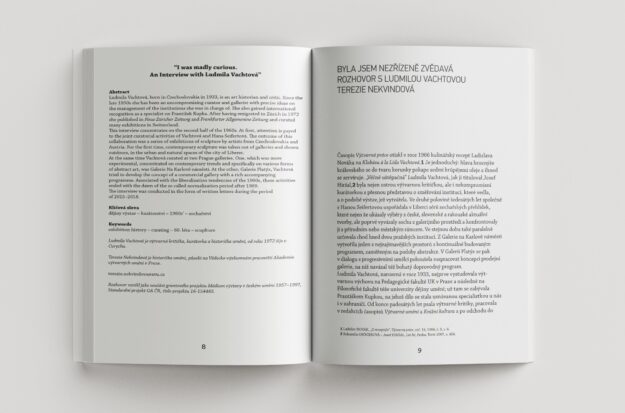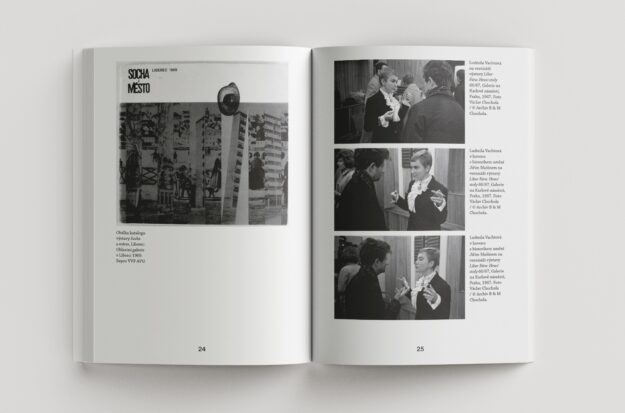The twenty-sixth issue of Notebook for Art, Theory and Related Zones revisits the history of exhibitions, which can be seen as a prism through which to look at art of the second half of the twentieth century. It contains an interview conducted by Terezie Nekvindová with the curator and critic Ludmila Vachtová, who used to draw up the programme not only for the gallery Na Karlově náměstí, but also for the Gallery Platýz, and participated in the preparation of a series of exhibitions in Liberec in the 1960s. There is also a text by Mária Orišková on two exhibitions of American art that took place in Czechoslovakia in 1947 and 1969. This is followed by a study of Jiří Valoch in which the author, Helena Musilová, examines an exhibition that Valoch prepared for the Brno House of Arts in 1980. Eva Skopalová and Marianna Placáková then focus on women in art from the 1950s–80s, both those that created and those that featured in their paintings. The issue closes with a text by Alise Tifentale on strategies of exhibiting photography at FIAP 1956.
Content
Terezie Nekvindová
“I was madly curious.” An Interview with Ludmila Vachtová
Ludmila Vachtová, born in Czechoslovakia in 1933, is an art historian and critic. Since the late 1950s she has been an uncompromising curator and gallerist with precise ideas on the management of the institutions she was in charge of. She also gained international recognition as a specialist on František Kupka. After having emigrated to Zürich in 1972 she published in Neue Züricher Zeitung and Frankfurter Allgemenine Zeitung and curated many exhibitions in Switzerland.
This interview concentrates on the second half of the 1960s. At first, attention is payed to the joint curatorial activities of Vachtová and Hana Seifertová. The outcome of this collaboration was a series of exhibitions of sculpture by artists from Czechoslovakia and Austria. For the first time, contemporary sculpture was taken out of galleries and shown outdoors, in the urban and natural spaces of the city of Liberec.
At the same time Vachtová curated at two Prague galleries. One, which was more experimental, concentrated on contemporary trends and specifically on various forms of abstract art, was Galerie Na Karlově náměstí. At the other, Galerie Platýz, Vachtová tried to develop the concept of a commercial gallery with a rich accompanying programme. Associated with the liberalization tendencies of the 1960s, these activities ended with the dawn of the so-called normalization period after 1969.
The interview was conducted in the form of written letters during the period of 2015–2018.
Mária Orišková
US Modern Art Exhibitions in Communist Czechoslovakia and the Ambivalent Agenda of Cultural Diplomacy
The paper examines the reception of American art exhibited in Czechoslovakia from the late 1940s tothe 1960s and reflects on the goals of US cultural diplomacy. This period was bookmarked by the two major, and only, exhibits, Advancing American Art (Prague, Brno, Bratislava, 1947) and The Disappearance and Reappearance of the Image: Painting in the United States since 1945 (Bratislava, Prague, 1969). Organized within the framework of ‚inter-state cultural agreements‘, these traveling exhibitions were official undertakings of the highest state interests. Implemented under strict state supervision, they played a specific role in the broader context of Cold-War ideological conflicts. At the same time, they were not generally seen as an instrument of US propaganda in Central Europe. On the contrary, both art critics and the general public welcomed these exhibitions as a genuine effort toward better understanding, cooperation, and the bringing together of the two nations. In retrospect, contradictions that textured much of these cultural diplomatic exhibitions came to be recognized. In the specific context of Czechoslovakia during communism, America officially functioned as an ideological Other. However, the anti-communist opposition gradually formed during the 1960s was constructed not by negation of the Western/US Other but rather by negation of the Soviet Other. At this juncture two narratives in relation to the USA and its political system, lifestyle, art and culture can be recognized: cultural diplomacy as a Trojan horse or foreign policy and/or an altruistic line of cultural diplomacy.
Helena Musilová
Současná česká kresba [Contemporary Czech Drawing]: Jiří Valoch and the Possibility of Organizing a Collective Exhibition during the so-called Normalization Period
In 1972 Jiří Valoch was employed as a curator by the The Brno House of Arts – the only Kunsthalle-based institution in then Czechoslovakia. The director Adolf Kroupa and his colleagues were trying to combine the tradition of the interwar avant-garde with the finest foreign art and to give space to ongoing trends. Valoch had considerable curatorial experience already and a network of contacts abroad – but at the same time, he was only 26 years old, which made him one of the young, promising ‘cadres’, seemingly unburdened by the past. Thanks to his professional and personal partnership with Gerta Pospíšilová (the director of The Brno House of Arts until 1975), he had relatively substantial possibilities to organize exhibitions both at home and abroad, as well as exhibitions of his own work.
The theme of the paper is the preparation of the Současná česká kresba [Contemporary Czech Drawing] exhibition (The Brno House of Arts, 1980). Valoch’s original intention was to present a wide range of approaches to drawing, ranging from the traditional to project-based and conceptual art. It should also have included artists who could not exhibit in any other official exhibition places, mainly in Prague. The article describes the methods of curtailing the original intention, the work of the approval committee, and the exclusion of certain artists. In the end, the realization of the exhibition brought Valoch noticeable sanctions (a ban on publishing his texts in exhibition catalogues and newspapers for a few years and compulsory tasks at The House of Arts). The paper also shows that the possibilities of collective exhibitions varied a lot in the so-called Eastern bloc countries – some collective exhibition projects in which Valoch participated or which he conceived in Poland in the 1970s can be seen as a counterpart.
Marianna Placáková, Eva Skopalová
Women Exhibiting, Women Exhibited. The Official Politics of Art Exhibitions during the So-Called Period of Normalization
The authors of the present paper will focus on the official Czechoslovak politics of art exhibitions during the so-called period of normalization in the context of gender politics. Following several examples, they discuss the outcomes of gender politics based on the percentage contribution of women to art exhibitions and their involvement in art institutions. Simultaneously, they debate the phenomenon of the idea of gender equality promoted through art exhibition – annual shows to celebrate International Women’s Day, and the exhibitions dedicated to International Women’s Year, designated by the United Nations to 1975. The Czechoslovak socialist gender politics that in the 1970s and 1980s promoted a pro-family agenda, as well as essentialist discourse of the period, both of which deeply influenced art exhibition politics, art criticism and also art production will also be addressed.
Alise Tifentale
FIAP Biennial in Photokina 1956: A Revolt Againts the Unvesrsal Language of Photography
Photography is a universal language, “understood on all five continents, irrespective of race, creed, culture or social level”—this announcement by Maurice van de Wyer, the president of the International Federation of Photographic Art (Fédération internationale de l’art photographique, FIAP), echoed numerous other assertions made at the opening of the fifth annual photography trade fair and exhibition complex Photokina 1956 in Cologne, West Germany, from September 29 to October 7, 1956. The leaders of the U.S. and West Germany, international organizations such as UN and UNESCO, photography industry, and transnational community of photographers united in FIAP all praised photography as a universal language. Photokina 1956, however, revealed two radically different understandings of such a language. On one hand, it denoted Western European and U.S. magazine photography whose success and popularity was driven by the market forces of the publishing and photo industries as well as by the support from politicians. On the other, it entailed numerous, idiosyncratic visual languages coming from photographers from thirty-six countries in Western and Eastern Europe, Latin America, Asia, and Africa represented in the fourth FIAP Biennial, which was included in the program of Photokina 1956. This article views the intervention of FIAP in the Photokina 1956 exhibition through a sociological lens that focuses on the contested social status of photographers and the power inequality in postwar photography.
Text was published in English.



